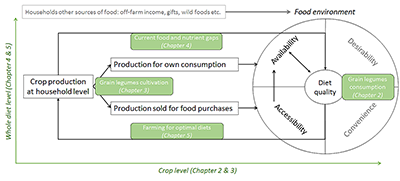In June I successfully defended my thesis entitled ‘Harvesting nutrition. Grain legumes and nutritious diets in sub-Saharan Africa!’ What a special day!
The figure below shows an overview of the studies we conducted within a framework based on the theoretical concepts of agriculture and nutrition pathways and the food environment. The main pathways that recur in literature through which agriculture may affect nutrition outcomes are: the production-own consumption and the income-food purchase pathway. The food environment links agricultural production and income on the one hand with consumption on the other hand.
 |
Ilse answering the questions of the opponents during her defence, with her paranimphs on the foreground |
The food environment is defined as the availability, affordability, convenience and desirability of various foods that affects people’s food choices and therefore diet quality. My PhD research focussed on the food availability and affordability in the food environment, as agricultural production of rural households will most directly affect these two elements. The framework was studied at two levels: (1) at crop level, addressing the potential role of grain legumes in relation to diet quality (Chapter 2) and the potential of grain legumes production of households and nutrition outcomes (Chapter 3) and (2) at whole diet level, using a systems approach, investigating on the one hand the current contribution of the crop production in a household to high quality diets (Chapter 4) and on the other hand the optimal combination of crop production to ensure a high quality diet in all seasons (Chapter 5). Our main findings include:
- The main contribution of legumes to nutritious diets is in terms of micronutrients intake and not protein intake.
- A project promoting grain legume cultivation will not necessarily result in dietary improvements but depend on the food environment, whether a nutrition-specific goal is set and activities such as nutrition behaviour change communication and women’s empowerment are included.
- A mixed method design including pathway analysis is a good approach to study nutrition impact of agriculture interventions when RCTs are not possible.
- Investigating the gaps in food availability and food needs for nutritious diets using a systems approach provides useful insights to be able to better coordinate and integrate nutrition across agricultural interventions and investments.
My thesis will be publicly available via the Wageningen University Library site from half June 2020.
Thank you all for making this a great project to work in!
Ilse de Jager, Wageningen University & Research, The Netherlands (Click here for her 2018 update)

